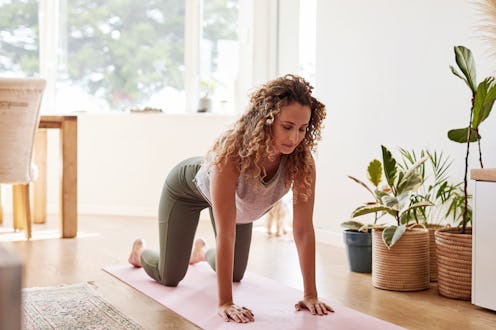Fitness
Why Folks On #FitTok Are All About Quadrupedal Movement Training
Bear crawls and crab walks and inchworms — oh my.

If you ever see someone scrambling across the gym on all fours, don’t be alarmed: They’re probably just doing a quadrupedal movement. This is the latest workout craze on FikTok where folks are bear crawling, inchworming, and crab-walking their way to improved strength and mobility.
Quadrupedal movements are a group of exercises that happen on all fours. The moves are part of the wider primal fitness trend, says Benjamin Sweeney, the head coach and general manager of CrossFit Queens, which is popular thanks to the way it changes up your traditional movement patterns. Instead of sitting, running, or walking, you get down to scurry or crawl — and that switch-up brings loads of benefits.
If quadrupedal movements seem prehistoric, it’s because they kind of are. This type of exercise is meant to tap into to our evolutionary origins to work the body in a new (or old?) way, says Noah Neiman, CPT, a trainer and co-founder of Rumble Boxing. “The movements are incredible for working muscular coordination and providing a unique stimulus you can’t get working bipedal movements,” he tells Bustle.
Quadrupedal movements are a mainstay in HIIT classes, Neiman says, where it’s common to do rounds of bear crawls, for example. But that isn’t the only way to scuttle your way through a workout. Below, trainers explain everything you need to know about quadrupedal movements, as well as how to give them a try.
The Benefits Of Quadrupedal Movements
Since many quadrupedal movements — like bear crawls — often look like a plank in motion, it’s no surprise they’re a great way to increase your core strength. “The majority of the movements that you'll see require a lot of stability through the core as you work to resist the rotational forces of your crawl,” says Sweeney. This will light up your deep ab muscles and obliques. Add in a crawling motion, which puts a lot of your body weight on your shoulders, arms, legs, and hips, and you’ll ultimately strengthen those areas, too.
These moves do amazing things for your body’s overall mobility, as well. Get down low into a squat and it’ll improve your flexibility, joint mobility, and range of motion, says Mary Sabat MS, RDN, LD, an ACE-certified personal trainer. These full-body movements are like oil for your joints, as you move and bend in ways you don’t normally do on the average day. For that same reason, “crawling on all fours also challenges your balance and coordination,” Sabat tells Bustle. Unlike walking, which you do all day, you have to think twice as you crab walk or bear crawl.
Another bonus? Take one look at people doing animalistic quadrupedal movements on TikTok, and you’ll see that it looks like a lot of fun. “If you're like me and don't like to just sit down and stretch, then it’s an easy way to make your routine fun and interesting,” Sweeney says. “It's something you can do every day and see multiple benefits in your overall health and wellness.”
According to Sweeney, everyone should add more quadrupedal movements into their week. “If you're a beginner and don't know where to start, these are some great options you can do at home to work on developing core strength and start moving your body,” he says. “If you've been working out for a long time and need something new to add to your routine, then it's worth adding in for variety and to challenge your body in a different way than you normally would.” Here are a few exercises to try.
Quadrupedal Exercises
Bear Crawls
The bear crawl is a great full-body conditioning exercise. To try it, hold yourself up on all fours and walk forward one limb at a time. “The movement works your shoulders, arms, core, and quads without any equipment,” Neiman says. “Doing bear crawls regularly can build up total body strength — similar to planks.”
Inchworms
“This is an exercise most of us did back in school during gym class,” Sweeney says. To complete the perfect inchworm — and work your arms, core, and glutes — stand with your feet under your hips, then walk your hands out into a plank. Once you reach a high plank, walk your hands back towards your feet to stand up, then repeat.
Crab Walk
For stronger shoulders, flip over for a fun little crab walk. Sabat recommends sitting on the ground with your hands behind you and your fingers pointing towards your feet. Lift your hips up and walk backward or sideways, alternating the movement of your hands and feet.
Spider Crawl
To do a spider crawl, get into a low push-up position. Crawl forward by bringing one knee up to the same-side elbow and then repeat on the other side. Think about imitating a spider’s crawling motion, Sabat says, as a way to work your arms, back, and core.
Gorilla Walk
Another option? An ape or gorilla walk. “It engages multiple muscle groups, including the core, shoulders, arms, legs, and hips, promoting overall strength development,” Sabat says. To do it, crouch down with your hands on the ground, just like a gorilla. Move forward by using your arms and legs simultaneously, making sure to stay low. If you look like you belong in the jungle, you’re doing it right.
Studies referenced:
Buxton, Jeffrey D. (2022). The Effects of a Novel Quadrupedal Movement Training Program on Functional Movement, Range of Motion, Muscular Strength, and Endurance. Journal of Strength and Conditioning Research. doi: 10.1519/JSC.0000000000003818.
Experts:
Noah Neiman, CPT, trainer, and co-founder of Rumble Boxing
Benjamin Sweeney, head coach, general manager of CrossFit Queens
Mary Sabat MS, RDN, LD, ACE-certified personal trainer
This article was originally published on